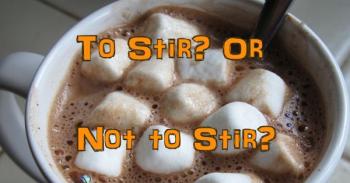Ask Professor Puzzler
Do you have a question you would like to ask Professor Puzzler? Click here to ask your question!
They say that if my hot chocolate is too hot to drink, I should stir it, because that helps to cool it down. But doesn't stirring increase the temperature by adding friction between the hot chocolate and the spoon?

Interesting question! You are correct that stirring will cause friction. Not just between the spoon and the hot chocolate, but also between the hot chocolate and the mug it's swirling around in. And, unless you are careful to avoid touching the spoon against the mug, there's also friction between the mug and the spoon.
And yes, if that's all that was happening, the temperature of your hot chocolate would rise (although probably not enough that you would notice it!).
But there's something else happening here. Heat is transferring from your hot chocolate to the cooler air above it.
And here's why stirring could make a difference: heat transfers more rapidly when there's a larger temperature difference. You know this, because your house loses heat more quickly in the winter than it does in the spring. If the temperature outside is 0ºC, you'll lose heat more rapidly than if the temperature was 15ºC.
Similarly, your hot chocolate is losing heat to the air above it. The air above your mug is warming up, while the hot chocolate is gradually cooling down.
The problem is, your hot chocolate is not losing heat uniformly. The surface is cooling down rapidly, while deep in the mug it's still very hot. You can test this for yourself. Scoop a spoonful of hot chocolate from the surface and drink it, then take a spoonful from deeper in the mug. You'll find that the deeper spoonful is hotter. So the surface is cooling rapidly, while underneath it is not. As the surface of your hot chocolate cools down, and the air warms up, the temperature difference is decreasing. And if the temperature difference is decreasing, that means that the rate of heat loss is decreasing.
Meanwhile, the deeper-down hot chocolate is gradually losing heat to the cooler upper layer, but that's a slow process.
How to speed that process up? Stir your hot chocolate occasionally! That'll bring some of the hotter beverage to the surface. Now you'll have a higher temperature difference, and the rate of heat loss will increase.
Incidentally, while we're on the subject of heat loss, you can also help your hot chocolate cool down faster by moving it around on the table periodically. After all, every time you move it away from the air it has heated up, to cooler air, you've increased the temperature difference again. Will that significantly increase the rate of cooling? Probably not, but it'll make you feel like you're doing something useful while you wait, which is probably the real reason people stir in the first place!

